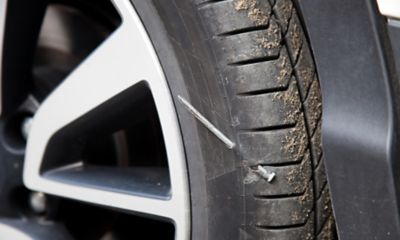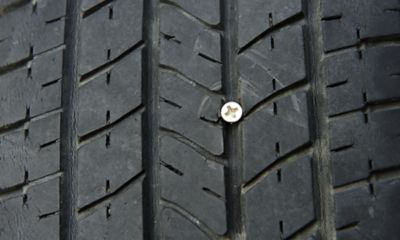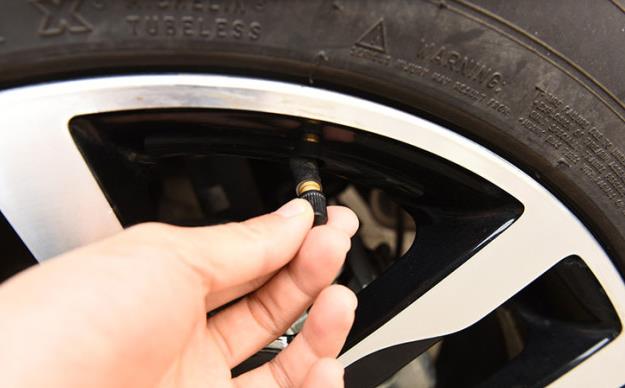Flat Tire Repair: Cost and Common Concerns
We've almost all been there — that crushing moment when you either notice a flat tire on your vehicle or feel the telltale bumpiness and lowering on one side of your vehicle.
Although inconvenient and annoying, flat tires are a fact of life. Flat tire repair doesn't have to be stressful, as long as you act quickly to mount your spare and either get the flat fixed.
Is My Flat Tire Repairable?
The good news is that flat tires are often repairable and don't need to be replaced. The most common culprits that cause flat tires are tiny nails and screws — those that are \u00bc" or less in diameter — that get lodged in your tire's tread.
If the nail, screw or other foreign object causes a puncture in your tire's tread that is more than \u00bc" in diameter or if the puncture occurs in your tire's sidewall, then you're most likely out of luck — attempting to repair such punctures is generally not recommended, because it's impossible to ensure that the patched tire complies with safety standards.
If the tire is not repairable, then you'll be looking at the cost of a new tire, or two, since it's best to replace tires in sets of two or four to maintain even wear. It might sting initially, but replacing tires in sets will surely save you money in the long run.
Flat Tire Repair Cost
If your flat tire is repairable, when you take your vehicle in to get it fixed, many shops and technicians will offer to check it out and patch it up for little or no cost.
If you're desperate and need a temporary solution to get you by before taking your tire in for proper, professional repair, you could attempt to seal it yourself. This will run you the cost of a tire puncture sealant or a tire plug kit — either can vary in cost from five to 25 dollars or more. If you already own or have access to the tools needed to detect the leak, loosen lug nuts and jack up your vehicle, a tire plug kit may be a great short term option. If you find yourself needing to use a tire sealant, do note that a tire sealant can ruin your tire pressure monitoring system (TPMS) sensor, so if you choose this temporary solution, you may have to factor in that cost as well.
Keep in mind that driving on a tire that's completely flat for any amount of time can ruin the sidewalls of the tire and cause wheel damage, which is far more expensive than the cost of repairing or replacing a flat. That said, be sure to immediately mount your spare tire or call for roadside assistance.
How to Detect a Leak in a Flat Tire
If you're interested in finding out exactly where the leak is coming from and in order to find the leak, your tire must be fully inflated.
Step 1: Fill — Fill up your flat tire. Get out that air compressor or bike air pump, and start inflating the tire until it is back up to the proper pressure, as instructed in your vehicle's owner's manual.
Step 2: Look — Visually scan your tire for any obvious objects or holes. Once your tire is inflated again, sometimes it's super easy to see why it went flat in the first place. Perhaps you'll see a little nail sticking out, an obvious cut in the rubber or a hard-to-miss hole.
Step 3: Listen — Listen to see if your tire is making a hissing noise. If you're unable to visually detect the problem right away, then just be quiet for a moment — you may be able to hear a faint hissing sound coming from the tire. If you can hear the hiss, you'll be better able to track it to the leak.
Step 4: Feel — Run your hand over the tire to see if you feel any air. If you couldn't see anything upon initial inspection and couldn't hear a hissing sound, then you may be able to feel the air leaking from your tire.
Step 5: Soap and water — If all three of the aforementioned "look, listen and feel" methods fail and you're still not able to locate the leak, then you can always resort to the soap-and-water solution. Get yourself some dish soap, and mix it in a bowl of water until it's nice and sudsy. Simply coat your tire with the soapy water, and watch for bubbles. As air escapes from the hole in your tire, it creates bubbles, and voilà — you've found your leak.
How to Fix a Flat Tire
Success! You've located the leak that caused your flat tire in the first place. Now for the fun part — getting it fixed.
It's best to have a trained technician repair your flat tire at a tire center or an auto repair shop. If, however, you don't have a spare tire or can't get immediate professional assistance from a trained technician, as mentioned earlier you can attempt to temporarily seal the leak using a can of tire puncture sealant or a tire plug kit. Keep in mind that both of these options should not be considered long-term solutions, but rather temporary fixes until you can take your vehicle in to the shop to have your tire professionally patched.
The can of puncture sealant attaches to your valve stem and releases its contents inside your tire, usually sealing the hole or cut for three days or 100 miles, tops. Tire plug kits, on the other hand, require tools, many more hands-on steps and greater technical know-how. Still, we reiterate: take your tire to be professionally repaired or replaced soon after sealing or plugging it.


























